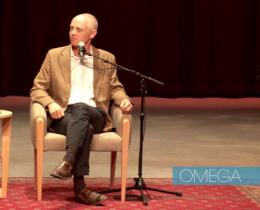Omega: How can we learn to settle our minds when the world around us is so full of news, information, social media, and more?
Tim Olmsted: When we talk about settling our minds, we need to first develop a little bit of an understanding about what mind means in this context. From the point of view of the meditation tradition, we can talk about the essence of mind and the expression of mind. The analogy would be like an ocean. The waves are the expression of the ocean, they’re not different than the ocean but they’re simply the surface of the ocean. The essence of the ocean is the vast, clear, deep body of water that we think of when we think of ocean.
When you talk about settling our minds, what we’re talking about is settling the kind of surface chatter sometimes referred to as monkey mind. Through meditation, we can learn to allow the waves on the ocean to settle a little bit. But the main point of meditation is to discover that vast, deep, clear ocean-like quality that is the essence of mind or the nature of mind.
In meditation, we develop a familiarity with that quality of mind. That quality of mind, just like the ocean, is never changing, it’s completely vast. It’s clear, and it’s always available to us. We always have access to that quality of mind. In meditation, we refer to it as awareness. Awareness itself never changes. It’s always stable. The experience of that awareness is the experience of equanimity and basic well-being.
When we learn to meditate, we’re learning to associate with or identify ourselves with the unchanging, clear, vast aspect of mind and from that point of view, the choppy water on top of that ocean becomes much easier to navigate.
Omega: One of your past workshops here at Omega was called “Making Friends with Your Mind.” Can you explain how we can begin this journey?
Tim Olmsted: When we talk about making friends with mind, what we’re talking about is making friends with the contents and experiences that are the surface of mind—this kind of monkey mind. There’s two ways to go about it. One is to work with discovering the unchanging basis of mind. The other is to work with the experiences that we have in our life—our hopes, our fears, our ups and downs, and our monkey mind. We can never really work with it successfully or skillfully, if there’s not some fundamental attitude of embracing or accepting our experience. We can never change directly what comes into our mind. If we try to change it or focus it or quiet it down, it will just get louder and crazier.
The first real byproduct of meditation is a deep and intuitive experience in relationship to our own mind. When we develop this kind of intimacy, we naturally warm up and things loosen, and relax. This openness and this relaxation changes our experience.
Omega: What’s one of the most common misperceptions about living a spiritual life?
Tim Olmsted: From the Buddhist point of view, we don’t make the distinction between the spiritual and mundane. Everything is an expression of mind. Everything is similarly interesting, profound, and worthy of our care. If we call this spiritual, that’s great. If we call it how to be a good human being, that’s fine, too.
My first teacher said that spiritual means that there’s a general sense of spiritedness and that definition really works for me. In the path of meditation, we develop a quality of humor, a sort of uplifted and energized quality, which is available to all of us right in the beginning of our meditation practice. I would call that spiritual.
Omega: You’ve talked about the difference in time spent on the meditation cushion vs. time spent in an open state of mind. How can we increase our ever-present state of mind?
Tim Olmsted: The word in Tibetan for meditation means “to become familiar with.” What we’re becoming familiar with is mind as the nature of mind, and mind’s world. On the cushion we develop, as I said before, a kind of intuitive sensitivity—a real natural sense of accommodating mind and mind’s world. We develop it formally on the cushion, and then because we’re familiar with it, we’re able to access that open presence throughout the day. But we can’t put the cart before the horse. We can’t hope to develop it without formal training. It’s harder and harder for people to accept that reality, but it is the way it is. If we don’t train on the cushion or chair or wherever, formally, we’ll never develop that natural familiarly, and then we’ll get disappointed in the path.



